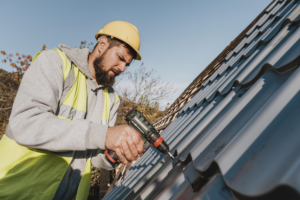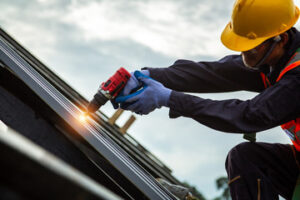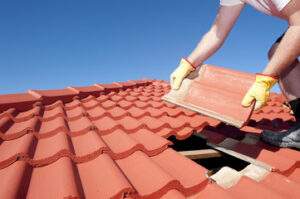A roof is an integral part of a building that shields the interior from rain, snow, wind, and sun. In addition to its protective role, it enhances a home’s appearance and can boost its value.
A strong roofing system begins with framing rafters or prefabricated trusses. Then comes sheathing, usually plywood or oriented strand board (OSB). The valley and ridge of a roof require specific shingles called hip and ridge shingles. Contact Erie Roofing Company now!

Roofing is an ancient practice that has come a long way from its humble beginnings. It is a reflection of human ingenuity and adaptability, continually evolving to meet the needs of changing environments and aesthetics. Originally, roofing was simply to provide shelter from the elements. However, it has since evolved into an integral part of a structure’s aesthetic, as well as providing insulation and structural support.
The first roofs were constructed using whatever materials were available in the surrounding environment, such as animal skins, mud, branches, and rocks. Archaeological evidence indicates that these primitive constructions were used as early as 40,000 years ago, when people began to live in caves for shelter against the elements.
In the following centuries, as societies advanced and technological advancements were made, more durable and fire-resistant building materials started to emerge. One of the biggest milestones in roofing occurred during the Renaissance, when elaborately crafted slate and terra-cotta tiles were introduced. These new roofing materials allowed architects to create more complex designs, such as curved roofs.
Throughout the 19th century, wood shingles became increasingly popular in North America, and were often treated with pine pitch and linseed oil to provide protection against rain and sunlight that cause deterioration. This treatment also gave shingles their characteristic colors of gray, brown and red. However, this type of roofing was not a safe choice for high-rise buildings because of the flammability of the wooden shingles. The introduction of clay tiles in the Mediterranean region marked another significant improvement in roofing, as these were fired in kilns and offered better water resistance and durability. This technology was eventually brought to North America, where it is still in use today.
Materials
Roofing material is the outer protective layer that shields the building from the elements. The materials vary and may include natural products such as thatch, sand or straw; commercially produced products like asphalt shingles, clay tiles and corrugated galvanized iron; and specialized metals. Most of these are placed on top of a secondary water-resistant product called underlayment.
A popular residential choice, asphalt shingles are available in a wide range of colors and styles and are easy to install. They are relatively inexpensive, provide good insulation, and offer an average lifespan of 20 to 30 years.
Wood shingle and shake roofs are attractive and durable but are expensive to replace if they sustain damage from wind, hail or fire. Young growth cedar is a good roofing material but will only last 30 to 50 years in relatively dry climates. Older growth cedar and redwood are much more durable but can be damaged by rot or insects. Slate is a beautiful roofing option with long life expectancy but can be expensive and heavy. Synthetic slate tiles are often used for the look of traditional slate at a lower cost and weight.
Galvanized steel roofing, usually coated with a coloured alloy of zinc and aluminum, is common in industrial applications but is also popular on residential roofs. It is light in weight and has very favorable fire ratings and impact resistance for elements such as hail.
Choosing the right roof material for your MLM home improvement project requires careful consideration of several factors. These include the durability, waterproof protection and insulation needs of your home, maintenance requirements, cost, aesthetics and the local weather conditions. A professional contractor can assist you in your decision making process and guide you in the selection of the appropriate roofing materials.
Installation
Roofing is the process of installing a protective covering on top of residential or commercial buildings to shield against rain, snow, wind, sunlight and other environmental factors. It involves a complex set of processes, including inspection, preparation, installation, and cleanup. Depending on the building, type of roof and climate conditions, various roofing materials like shingles, metal sheets, tiles, slates or wood shakes can be used. Besides providing protection, roofing also offers insulation and enhances the aesthetic appeal of the structure.
Before starting the actual work, our roofing contractors will inspect your current roof and identify any problems that need to be repaired. They will also provide a detailed estimate and help you select the best roofing materials that meet your needs and budget. They will take into account all the small details of your project to ensure that everything is covered and to your satisfaction.
The next step is removing the old roof and prepping the new one for installation. This includes laying underlayment to add additional support and prevent moisture penetration; flashing around chimneys, vents, and roof edges to prevent leaks; and shingling or other roofing material in a pattern that protects the building against weather elements while enhancing its aesthetic appearance.
During the installation process, our roofing contractors will be using specialized equipment that can create a lot of debris. To minimize the mess, they will cover any landscaping or shrubs on your property with tarps and ensure that all open drains are covered to avoid blocked drainage. They will also clean up any debris and trash left behind after the installation is complete.
Repairs
When a homeowner encounters damage to their roof, they have two choices: repair or replace. Repairs involve covering over existing shingles with new ones in order to correct the damage and restore the functionality of the roof. The cost of these repairs is lower than that of replacing the entire roof, making them the ideal choice for budget-conscious homeowners.
However, repairing a damaged roof is not without its drawbacks. First, a second layer of shingles cannot provide as good an aesthetic finish as the original roofing materials. Furthermore, since the old shingles are not removed, it’s impossible to know what type of damage exists underneath. Re-roofing may also void the warranty of the new shingles and prevent them from lasting as long as a replacement roof.
Homeowners who engage in regular repairs and inspections of their roofs are able to detect potential issues that can threaten the integrity of the structure. They can then address these problems before they have a chance to escalate into costly leaks and structural damage.
In addition, roofing repairs can make a house more energy-efficient by reducing the amount of air that escapes or infiltrates the building. As a result, this can lead to reduced utility bills and a more sustainable living environment. In the event that a roof is compromised, it can allow mold and mildew to grow inside the building. This can create health and safety risks for people with respiratory conditions or allergies. A leaking roof can also increase the chances of water or moisture damage to furniture, carpeting and other interior components.
Maintenance
Roofing is an important component of building construction that protects the interior from weather elements like rain, wind, snow, sunlight and heat. It also provides insulation and structural support for the interior of a building. Roofing can be made from different materials including asphalt shingles, metal sheets, tiles, slates, wood shakes and shingles or synthetic materials such as rubber or PVC. Roofing maintenance procedures include regular inspections, repair of minor damage, and replacement of worn shingles or other materials.
During a roof inspection, it is important to look at the overall condition of the roof deck and structure, as well as the integrity of the insulation and any visible signs of water damage. The most common causes of leaks are deteriorated or missing insulation, inadequate flashing and gutters, and the presence of moss or other vegetation. It is also important to examine the caulk around chimneys and vent pipes to make sure it is still properly sealing. The type of weather in a region will affect the condition of the roof, so an inspection should be performed each season.
Inspect the rooftop for accumulated debris, which can block drain lines and cause the roof to rot or decay prematurely. Also, regularly trim any trees near a flat roof to prevent branches from falling onto the surface during storms.
It is also a good idea to inspect all ladders, scaffolding and other equipment that is used for roof maintenance, as this can be a source of accidents and injuries for personnel working on the roof. It is recommended to implement a multi-layered approach to fall prevention and protection that includes elimination, substitution, engineering controls and administrative controls as part of a comprehensive occupational safety program.


